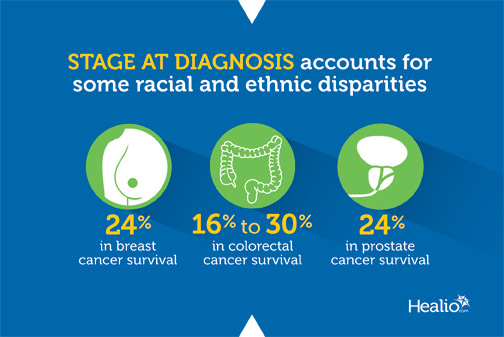Stage at diagnosis drives racial, ethnic disparities in cancer survival
Stage at diagnosis appeared to be a major driver of racial and ethnic disparities in cancer survival, study data showed.
“Disparities in [cancer] survival by race and ethnicity have been well documented, but the underlying causes are not well understood,” Libby Ellis, PhD, staff scientist at Cancer Prevention Institute of California, and colleagues wrote. “Various factors have been implicated as contributors toward racial/ethnic survival disparities; these include differences in tumor characteristics at presentation, disease management and treatment, factors that relate to the health care institution and sociodemographic and neighborhood characteristics.”
The researchers used data from the California Cancer Registry to estimate cancer-specific survival among black, Hispanic and Asian American and Pacific Islander patients — diagnosed with breast, prostate, colorectal or lung cancer between 2000 and 2013 — compared with white patients. Ellis and colleagues used a sequence of multivariable Cox proportional hazards models to estimate the contribution of various factors to ethnic and racial disparities in survival.
At all cancer sites, black patients had the lowest survival rate, whereas Asian American and Pacific Islander patients had the highest. Stage at diagnosis had the greatest impact on survival, accounting for 24% of racial and ethnic disparities in breast cancer survival, 24% in prostate cancer and 16% to 30% in colorectal cancer survival.
Socioeconomic status appeared as an important factor for all cancers among black and Hispanic patients, but not for white or Asian and Pacific Islander patients. Marital status also impacted racial and ethnic disparities, with the influence stronger among men than women. Although adjusting for covariables explained approximately half of OS disparities for colorectal, breast and prostate cancer, it explained only 15% to 40% of survival disparities in lung cancer.
“Stage at diagnosis had the largest effect on racial/ethnic disparities in survival for breast, prostate and colorectal cancers,” the researchers wrote. “Stage itself is influenced by a myriad of factors, which include socioeconomic status, health insurance, uptake of screening and access to health care.”
Influence from socioeconomic status and marital status suggested that “social determinants, support mechanisms and access to health care cannot be overlooked,” Ellis and colleagues wrote.
“In clinical settings, ensuring that these social determinants are assessed, and that barriers to care for vulnerable populations are addressed, may go a long way toward the reduction of cancer survival disparities,” the researchers wrote. – by Andy Polhamus
Disclosures: The authors report no relevant financial disclosures.

